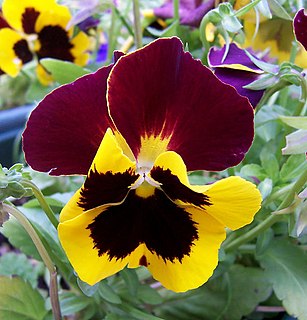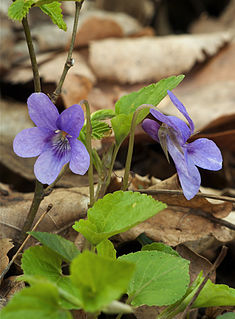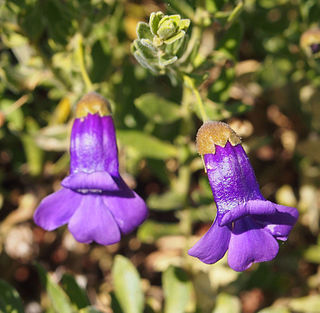
The garden pansy is a type of large-flowered hybrid plant cultivated as a garden flower. It is derived by hybridization from several species in the section Melanium of the genus Viola, particularly Viola tricolor, a wildflower of Europe and western Asia known as heartsease. It is sometimes known as Viola tricolor var. hortensis, but this scientific name is ambiguous. While Viola tricolor var. hortensisGroenland & Rümpler is a synonym of Viola × wittrockiana, Viola tricolor var. hortensisDC. refers to a horticultural variety of wild pansy that had been illustrated in Flora Danica in 1777 before the existence of Viola × wittrockiana.

Viola is a genus of flowering plants in the violet family Violaceae. It is the largest genus in the family, containing between 525 and 600 species. Most species are found in the temperate Northern Hemisphere; however, some are also found in widely divergent areas such as Hawaii, Australasia, and the Andes.

Angophora is a genus of nine species of trees and shrubs in the myrtle family, Myrtaceae. Endemic to eastern Australia, they differ from other eucalypts in having juvenile and adult leaves arranged in opposite pairs, sepals reduced to projections on the edge of the floral cup, four or five overlapping, more or less round petals, and a papery or thin, woody, often strongly ribbed capsule. Species are found between the Atherton Tableland in Queensland and south through New South Wales to eastern Victoria, Australia.

Viola banksii, commonly known as native violet, is sold and grown throughout garden nurseries and grown and loved in gardens around Australia, especially in the east. For many years it was known as Viola hederacea, however, the species complex was revised in 2004 by Kevin Thiele, with the name Viola banksii being published in 2003 by Kevin Thiele and Suzanne Prober. Although the Native Violet was initially collected by Banks and Solander, the type specimen was either lost or not provided until a collection by Jacques Labillardière in Tasmania. Thiele discovered that the original type specimen of V. hederacea collected by Labillardière was not the same as the hardier and showier plant later collected, cultivated and widely sold. This second form, native to the east coast from near Brisbane to Batemans Bay, he named Viola banksii. This species is distinguished by its striking purple and white flowers. As well, the fully developed leaves are almost circular in outline with a deep, narrow, v-shaped sinus at the base, and are usually rather bright, fresh green.

Banksia nana, commonly known as dwarf dryandra, is a species of shrub that is endemic to a small area in the south-west of Western Australia. It has underground stems, pinnatipartite leaves with sharply-pointed lobes, pale green or yellow flowers and broadly egg-shaped follicles.

Eremophila macdonnellii, also known as MacDonnell's desert fuchsia, is a flowering plant in the figwort family, Scrophulariaceae and is endemic to Australia. It is a shrub with many tangled branches, which, along with the leaves, are often covered with many, sometimes long hairs. The flowers are deep violet or purple, and the species is widespread in Central Australia.
Verticordia argentea is a flowering plant in the myrtle family, Myrtaceae and is endemic to the south-west of Western Australia. It is an erect, open shrub with almost circular leaves and scented, pink and white flowers. It usually grows in sand and is found near Eneabba.

Viola betonicifolia, commonly known as the arrowhead violet, showy violet or mountain violet, is a small perennial of the genus Viola, which contains pansies and violets. It occurs from India and Pakistan in southern Asia throughout eastern Australia and Tasmania. It grows in shaded habitat in forests.

Viola pedatifida, known variously as prairie violet, crow-foot violet, larkspur violet, purple prairie violet, and coastal violet, is a perennial herbaceous plant in the Violet family (Violaceae). It is native to Canada and the United States.

Viola langsdorffii is a species of Viola. Commonly known as Alaskan violet and Aleutian violet, it is a plant from rather stout creeping rootstocks, glabrous, the stems ascending 5–30 cm long. V. langsdorffii has leaves that are long-petioled, round-cordate, and anywhere from 2.5 to 4 cm broad, crenate; stipules foliaceous, lanceolate, the lower usually incised. The flowers are pale violet, with petals 12–16 mm long, the three lower white at base, the lateral pair bearded; spur very short and stout, as broad as long; the head of styles not bearded. Alaskan and Aleutian specimens, with petals 20 mm long, are more robust than specimens from further south in it range.

Pterostylis banksii, commonly known as greenhood or tutukiwi, is a species of orchid endemic to New Zealand. Non-flowering plants have a rosette of leaves. Flowering plants have leaves on the flowering stem, some of which reach above the single relatively large, green flower with translucent white stripes. It is the most common, widespread and largest New Zealand greenhood and is found on both of the main islands.

Viola calcarata is a species of genus Viola that grows on mountains of south-eastern Europe. It is commonly known as long-spurred violet or mountain violet. It is a herbaceous flowering perennial plant.
Viola eminens is a perennial, stolon-spreading herb in the genus Viola, native to southeastern Australia.

Eremophila flabellata is a flowering plant in the figwort family, Scrophulariaceae and is endemic to Western Australia. It is a small shrub with serrated leaves, broad serrated sepals and pink, purple or mauve flowers.

Eremophila rotundifolia is a flowering plant in the figwort family, Scrophulariaceae and is endemic to Australia. It is a shrub with many tangled branches with its leaves and branches covered with a layer of silvery-grey hairs. Its flowers range in colour from pale to deep lilac. It is common in South Australia and there is also a single record from the Northern Territory.
Eremophila simulans is a flowering plant in the figwort family, Scrophulariaceae and is endemic to Western Australia. It is an erect shrub with broad, serrated leaves and violet to purple flowers.

Pityrodia loricata is a flowering plant in the mint family Lamiaceae and is endemic to Australia. It is a dense, greyish, multi-stemmed shrub with whorled leaves, prominent sepals and pale, pinkish-white flowers. It is common in Western Australia and the Northern Territory and there is a single record from South Australia.

Pterostylis decurva, commonly known as the summer greenhood, is a species of orchid endemic to south-eastern Australia. As with similar greenhoods, the flowering plants differ from those which are not flowering. The non-flowering plants have a rosette of leaves but the flowering plants have a single flower with leaves on the flowering spike. This greenhood usually flowers in summer and has a white flower with green stripes and a brownish tinge. It is similar to P. aestiva but has paler green flowers.
Pterostylis silvicultrix, commonly known as the Chatham Island greenhood or tutukiwi, is a species of orchid which is endemic to Chatham Island and nearby islands. Non-flowering plants have a rosette of leaves but flowering plants have leaves on the flowering stem, some of which reach above the single translucent white flower with dark green stripes. It is similar to Pterostylis banksii which occurs on both of the main islands of New Zealand but that species lacks the orange or reddish-brown tips on the flowers of this species.

Boronia rhomboidea, commonly known as the broad-leaved boronia or rhomboid boronia, is a plant in the citrus family Rutaceae and has a disjunct distribution in New South Wales and Tasmania in Australia. It is an erect, woody shrub with many branches, simple, broadly egg-shaped to almost circular leaves and groups of up to three white to pale pink, four-petalled flowers on the ends of the branches or in the axils of the upper leaves.
















